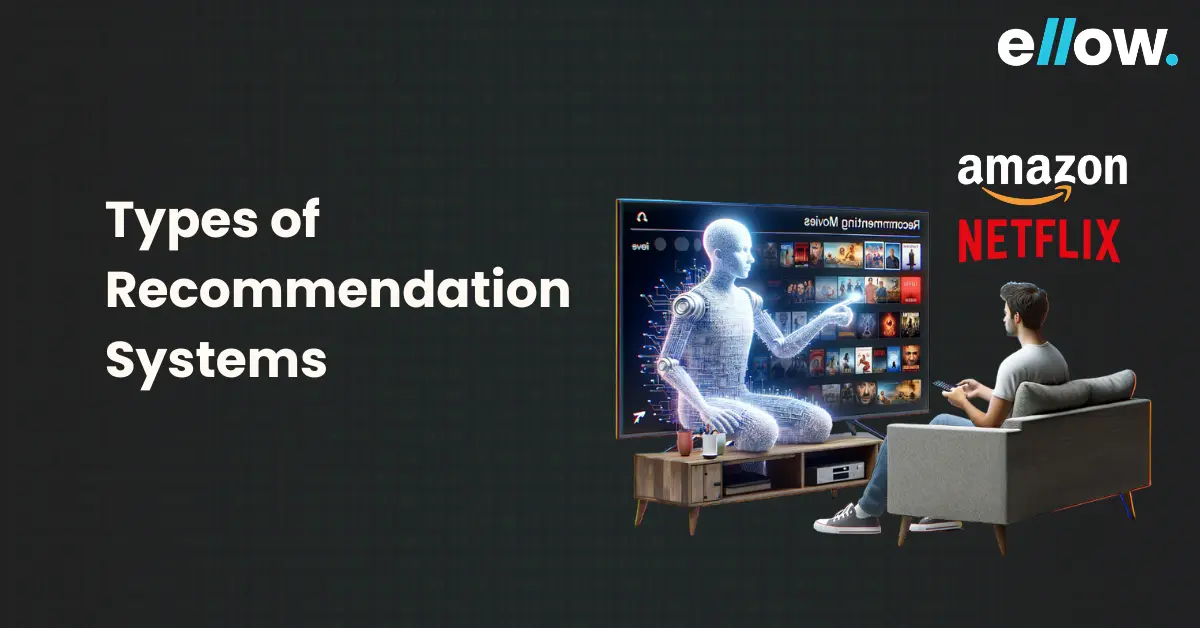Let’s build the future together.
Great ideas need great people. Partner with us to bring your vision to life, or take the first step in your career by joining our team of innovators.

Ready to discover how recommendation systems enhance user experiences and drive engagement? These powerful tools are pivotal in various industries, guiding users toward products, content, and services tailored just for them.
From the collaborative filtering that powers platforms like Amazon and Netflix, to the content-based systems that curate personal playlists on Spotify, and the hybrid models that combine the best of both—each type of recommendation system plays a crucial role in personalizing the digital landscape.
With statistics showing that up to 80% of watches on Netflix stem from recommendations, the impact of these systems is both profound and measurable.

This surge in reliance on recommendation engines is evidenced by their growing market, which, according to a study by Grand View Research, shows no signs of slowing down.
Reflecting on a thought by Steve Jobs, “Get closer than ever to your customers. So close that you tell them what they need well before they realize it themselves,” we see the true power of these systems—to understand and serve the consumer in an almost precognitive fashion.
Join us as we explore the types of recommendation systems, backed by examples that highlight their importance in our everyday digital interactions.
A recommendation system is a sophisticated technology that uses machine learning and data analysis to offer personalized suggestions to users. It gathers and studies user behavior, preferences, and past interactions with items.
Through intricate algorithms and statistical models, recommendation engines can forecast and present users with items, services, or content that match their interests and tastes.
There are several types of recommendation systems, such as collaborative filtering methods, content-based filtering, and user-based collaborative filtering, each with its approach to making recommendations.
These systems find widespread application across various industries, notably in e-commerce, streaming platforms, news and media, and digital marketing. Their purpose is to enhance user engagement, build user confidence, increase sales, and elevate overall customer satisfaction.
Recommendation systems gather data by tracking user actions like clicks, views, and purchases. They also take into account user feedback such as ratings and reviews, along with demographic information and browsing habits. This data helps understand user preferences and behavior.
By analyzing the collected data, recommendation systems predict what users might like. They look at various factors such as popular content, user feedback, and patterns in user behavior to make accurate suggestions. This analysis ensures that recommendations are relevant and personalized.
Recommendation systems use complex algorithms to process the data and generate recommendations. Different mathematical techniques are applied to refine the suggestions depending on the type of recommendation model used. The goal is to filter out irrelevant options and present the most suitable recommendations to users.
Finally, the recommendation system generates a list of potential options based on the user’s input. These options are then ranked based on their relevance to the user’s preferences. Artificial intelligence plays a crucial role in this process, continually learning and adapting to provide better recommendations over time.
Check this video out: How Recommender Systems Work (Netflix/Amazon)
Collaborative filtering is a widely used method in recommendation systems that relies on user-item interactions. There are two main types:
Content-based filtering recommends items based on their attributes and the similarity between them.
Hybrid recommendation systems combine collaborative filtering and content-based filtering to offer recommendations.
Deep learning-based recommendation systems employ deep neural networks to generate predictions or recommendations.
Shopify employs collaborative filtering techniques similar to Amazon. By analyzing user behavior, preferences, satisfaction, and purchase history, it generates data-driven product suggestions tailored to individual users. Shopify’s system also offers complementary and related product recommendations, enhancing the shopping experience for merchants and customers alike.
Amazon’s Kindle recommendation system utilizes advanced artificial intelligence algorithms and machine learning techniques to provide personalized book recommendations to users. By analyzing user behavior, browsing history, and purchase patterns, Kindle suggests books that align with individual preferences and interests, enhancing the overall reading experience.
Netflix’s recommender system tracks user behavior, including watched content, ratings, and viewing habits, to generate personalized movie and TV show recommendations. Utilizing matrix factorization, deep learning, and A/B testing, Netflix ensures that users receive relevant content suggestions that match their tastes and preferences, contributing to a more engaging streaming experience.
Spotify’s recommendation system analyzes user listening habits, utilizing collaborative and content-based filtering techniques. By considering factors such as song features, listening history, and user preferences, Spotify generates personalized playlists and song recommendations for each user. Additionally, natural language processing is employed to understand public sentiment and further enhance recommendation accuracy.
TensorFlow offers solutions for crop recommendation systems by leveraging machine learning algorithms to analyze agricultural data such as soil quality, weather patterns, and crop yield history. By providing personalized recommendations on crop selection, planting techniques, and pest management strategies, TensorFlow assists farmers in optimizing their agricultural practices and increasing crop productivity.
GetResponse utilizes AI/ML-driven recommendation models to deliver highly accurate and personalized content suggestions to users. Through AI-driven product recommendations, GetResponse matches product offerings to individual preferences, needs, and habits, enhancing the effectiveness of marketing campaigns and improving user engagement.
Additionally, GetResponse’s acquisition of Recostream further enhances its capabilities in AI product recommendations, contributing to a more tailored and impactful marketing strategy.
Incorporating recommendation systems into your digital platforms is a valuable investment. These systems improve user satisfaction and interaction and boost business earnings. Yet, crafting an effective recommendation system requires a deep grasp of data.
The success of your system hinges on its construction. If you want to build a machine learning recommendation system, hire developers from ellow.io to bring your vision to life.
Conversion-focused eCommerce App: 11 Best UX Practices for an eCommerce App
10 Popular Examples Of SaaS Applications
Advantages and Disadvantages of Javascript
Advantages and Disadvantages of Machine Learning
Recommendation systems are algorithms designed to suggest relevant items to users, such as movies, books, or products, based on their preferences and past behavior. They are widely used in online platforms to personalize user experiences and increase engagement.
The main types of recommendation systems are collaborative filtering, content-based filtering, and hybrid recommendation systems combining both approaches.

How Top SaaS Companies Build Agile Teams with Remote Developers

How to Hire Vetted Remote Developers in a Hyper-Competitive Market

Top 5 Countries to Hire Remote Developers (and Why)
Please feel free to share your thoughts and we can discuss it over a cup of tea.
Get a quote
How Top SaaS Companies Build Agile Teams with Remote Developers

Six Things to Consider When Hiring Remote Talent

ellow.io enters remote hires market with AI-based screening process